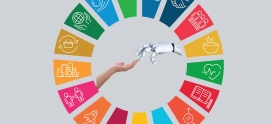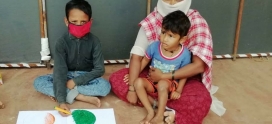Destiny of India is being shaped in the classroom
Fellow citizens, why do you turn and scrap every stone to gather wealth, and take so little care of your children to whom one day must you relinquish it all – Socrates
It may be trite to say that all-round development of our future citizens can be achieved by building a strong foundation in Education. That it is a unique investment in the present, bearing invaluable benefits for the future. You, dear reader, decide whether or not our collective efforts (or the lack of these) in this sphere, warrant such denigration or do the outcomes make us proud.
A key milestone in India’s march towards Education for all was the adoption of the National Policy on Education 1986 (revised in1992). This has been followed up by the Right to Education Act (RTE) 2009. Focus has been on universal access and enrolment, retention of children in schools up to 14 years of age and a substantial improvement in the quality of education to enable all children achieve essential levels of learning.
The investments in expansion of schooling facilities, bridging gender and social category gaps in elementary education, improving school infrastructure, Mid-day meal programme, etc. have helped in substantially reducing school drop-out rates evidenced by the improved retention rates in primary, upper primary and elementary education.
While, quantitatively, India is inching closer to universal education, the quality of education in government run schools is questionable. 70% of rural Indian children in the age group of 6-14 years go to Govt schools1. The last ASER (Annual Status of Education Report) 2014 started a nationwide debate on the learning outcomes of children in primary schools. As per the report, half the children entering middle schools cannot read a Std 2 level text and only one out of four children can solve an arithmetic sum usually taught in Std 3-4.2.
The Millennium Development Goals (MDGs) have helped in bringing out a much needed focus and pressure on basic developmental issues. MDGs originated from the Millennium Declaration adopted by the General Assembly of the United Nations in September 2000. As per the MDGs, the target is to ensure that, by 2015, every child should complete a full course of primary schooling. There were 3 indicators which were used to assess the development which are: Net Enrolment in primary education, retention rate of children from Grade 1 to 5 and increase in literacy rate of youth of ages between 15-24 years. Apart from Net Enrolment ratio, the trend in the other 2 indicators is steadily improving. The reason for decline in the Net Enrolment ratio is put down to decline in the demography of child population age 0-6 years.
Overall, as per the country report for MDG, the goals for education are “moderately on track “.3
There exists a learning crisis in India
The system suffers from massive gaps leading to poor learning levels. This could be attributed to a number of reasons such as lack of an adequate number of teaching staff exacerbated by the fact that many of the teachers are not professionally qualified. There is also a lack of accountability (poor teacher attendance) and motivation among the teaching staff which is a systemic challenge.
Need of the hour: Overhauling the system of teacher education with emphasis on continuing professional development of teachers. The education system in India, while having made significant progress in many aspects (such as access and reach), has left a lot to be desired from a quality perspective. Unless there is significant improvement in governance and teachers are properly trained, things are unlikely to change.
The country faces a shortage of 1.4 M teachers4. A reflection of this is seen in the Student /Teacher Ratio. As per data collected by us, 3 out of 10 upper primary schools have an average of 55 students to a teacher in the senior class. It is not coincidental that the learning levels in these schools are low. In some schools a single teacher is teaching children of classes 6, 7 and 8 with different learning levels. Further, as per the data, on an All India basis 20% of the schools have a single teacher with no back up.
The RTE Act has mandated that the student / teacher ratio be maintained at 30:1 for primary schools and 35:1 for High schools. The Act also mandates that above class 5 there should be a single teacher for each class and at least one teacher specializing in Science & Math , Social Studies and Language. But due to paucity of teachers these standards have not been implemented in every school.
“>In 2014, the Government initiated a Teacher Eligibility test (TET) to ensure that the teachers joining schools have a certain standard. Unfortunately, the results of the TET suggest that most of the teachers are not able to pass the test which underscores the poor quality of teachers.
As per a study on ‘Primary Education in India, a teacher’s ability, knowledge and his / her pedagogy, (i.e. his / her method of delivery) is one of the most critical factors that affect the learning outcomes of children.
Contribution by companies in the area of education under CSR:
As part of their CSR initiative, many corporates have spent large amounts on Education. Unfortunately, a large part of the CSR spend in the education sector is on infrastructure such as building girl toilets (given Government emphasis) and not enough on learning outcomes and pedagogy.
Corporates (through CSR) should invest in capacity building of teachers in partnership with NGOs. Some NGOs focus on capacity building of teachers through an ‘integrated teacher education’ program. The programme ensures that teachers are prepared for the classroom through theoretical and practical training. The programme focuses on skills such as school leadership, IT skills, and English proficiency and also covers pedagogy requirements for each subject. STIR Education, another NGO, identifies teachers as change makers and brings them together to initiate change in their own schools and in the broader ecosystem.
Considering that corporate contribution to education will continue to represent a fraction of government expenditure, the way companies spend, matters at least as much as the amount they spend. To maximize the impact of their contribution, companies need to be strategic in their approach to CSR. Doing so will allow them to play a stimulant role in the sector by developing innovative models for the Government to adopt.
In this context, it is worth mentioning that the Azim Premji Foundation, a not for profit organization, has been working for more than a decade on the quality and equity of education in India. The foundation works in collaboration with State Governments and engages with teachers, teacher educators, head teachers, block and cluster level education officials, senior government functionaries and policy makers at the state and national level. The Foundation works in 8 states with around 3,50,000 schools.
The Government, however, cannot shy away from its responsibilities to provide academic support to schools through a pool of trained teachers. Institutions like District Institute of Education and Training (DIET) & State Council for Education Research and Training (SCERT) have been created to contribute to the primary objective of providing pre-service and in-service training to elementary school teachers. These organizations exist but are operating sub optimally. There is a need to staff these nodal organizations adequately with people of high caliber who can institutionalize teacher training and direct the teams to work towards a unified vision of improving the quality of teachers and education in India.
Investing in improving teacher’s capabilities is probably the most sustainable way of bringing about a much-needed improvement in student learning and needs active support from the private sector.




